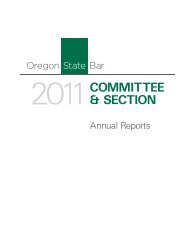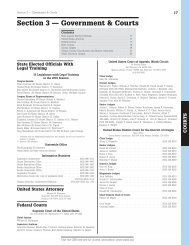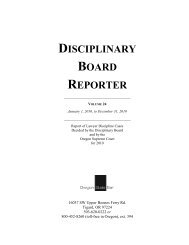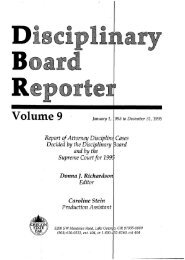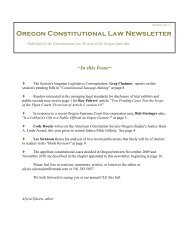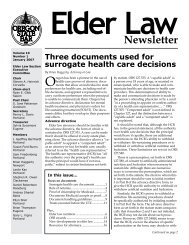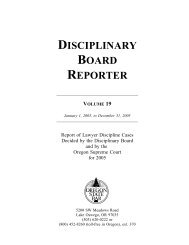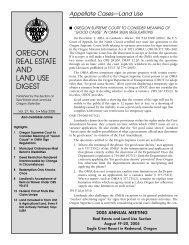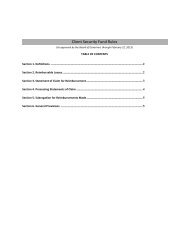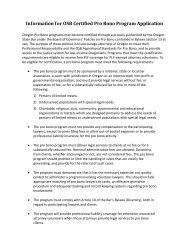February 22, 2013 - Oregon State Bar
February 22, 2013 - Oregon State Bar
February 22, 2013 - Oregon State Bar
Create successful ePaper yourself
Turn your PDF publications into a flip-book with our unique Google optimized e-Paper software.
unable to establish that 19th century prohibitions on public nudity were sufficient to<br />
establish an historical exception for the regulation of live sex shows. <strong>State</strong> v. Ciancanelli,<br />
339 Or 282, 321-<strong>22</strong>, 121 P3d 613, 634-35 (2005); see also, Zackheim v. Forbes, 134 Or App 548,<br />
550 (1995) (historical prohibition on access to public records insufficient to establish<br />
historical exception for limiting the use of public records). The requirement for a<br />
historical exception to justify an express limitation on the content of speech is<br />
particularly significant as to lawyer advertising and solicitation for one simple reason. In<br />
and before 1859, and indeed for some time thereafter, advertising and solicitation by<br />
<strong>Oregon</strong> lawyers and non-<strong>Oregon</strong> lawyers was not prohibited. For the most part, those<br />
limitations did not take hold until the early 20 th Century.<br />
Second, when a law focuses on forbidden results but expressly prohibits forms of<br />
speech used to achieve those results, the court will analyze the law for potential<br />
overbreadth. See e.g. <strong>State</strong> v. Moyle, 299 Or 691, 705 P2d 740 (1985) (harassment statute<br />
upheld where statute required unambiguous and genuine threat to person or property<br />
that causes actual alarm); <strong>State</strong> v. Garcias, 296 Or 688, 679 P2d 1254 (1984) (menacing<br />
statute upheld). This limitation is significant as to lawyer advertising and solicitation<br />
because the present blanket prohibition against in-person or real-time electronic<br />
solicitation prohibits not only communications that may be untruthful or misleading or<br />
that may involve duress or harassment but also many other communications that would<br />
not involve any such concerns. We also are aware of no empirical justification for the<br />
view that lawyers who engage in some or all forms of advertising or solicitation will<br />
necessarily be less honest, less competent or less diligent than their non-advertising and<br />
non-soliciting colleagues.<br />
Third, reasonable restrictions—as distinct from outright prohibitions, on the time,<br />
place or manner of speech—may be upheld. See, e.g., Outdoor Media Dimensions, Inc. v.<br />
Dept. Of Transportation, 340 Or 275,288-89, 132 P2d 5, 12 (2006) (content-neutral permit<br />
and fee requirements for highway signs permissible under this category); City of Hillsboro<br />
v. Purcell, 306 Or 547, 761 P2d 510 (1988) (ordinance banning all door-to-door solicitation<br />
unconstitutionally overbroad, though reasonable limitations would be permitted). In<br />
other words, laws that restrict speech, but do not prohibit it entirely, may be<br />
constitutional if sufficiently narrowly tailored to meet specific, clearly expressed and<br />
permissible objectives. In In re Lasswell, 296 Or 121, 673 P2d 855 (1983), for example, the<br />
court upheld the constitutionality of <strong>Oregon</strong>’s former rule limiting pretrial publicity as<br />
applied to lawyers involved in a case, but only as long as a “serious and imminent threat”<br />
to a fair trial could be shown. At the same time, the court noted that it would be<br />
impermissible to restrict the expression of lawyers merely because they were lawyers. Id.<br />
at 125. By definition, a wholesale ban on in-person or real-time electronic solicitation is<br />
not a reasonable restriction on time, place or manner. For much the same reason, the<br />
Majority also believes that a 30-day waiting period on in-person or real-time electronic<br />
solicitations would not be a reasonable time, place and manner limitation within the<br />
meaning of Article I, Section 8. If nothing else, there are times when a potential client<br />
may choose to or have to act in less than 30 days and in which a delay of notification<br />
could prove harmful.<br />
Report of the Advertising Task Force (August 2009) Page 5




